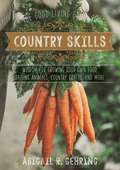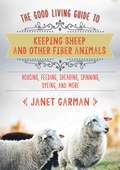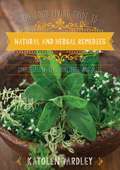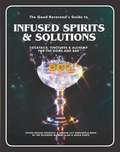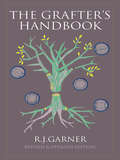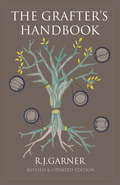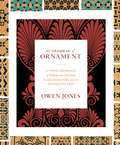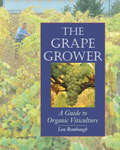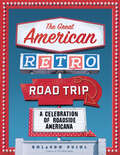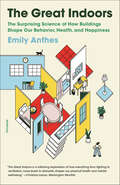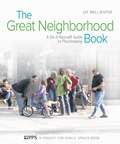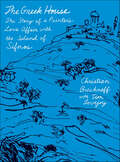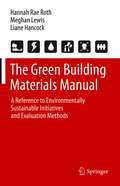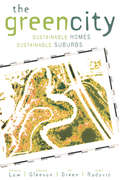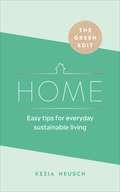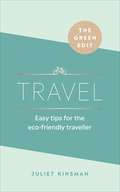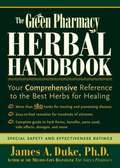- Table View
- List View
The Good Housekeeping Household Encyclopedia
by Good HousekeepingHow to manage a household, with a variety of tips and techniques.
The Good Life Lab: Radical Experiments in Hands-On Living
by Dale Dougherty Sandor Ellix Katz Wendy Jehanara Tremayne Christopher Bamford Brad Lancaster Alyce Santoro Pir Zia Inayat-Kahn The Reverend Billy Doug RushkoffTired of the high-pressure life they lead in New York City, Wendy Jehanara Tremayne and her husband migrate to Truth or Consequences, New Mexico, where they build, invent, forage, and grow all they need for themselves. Full of quirky stories and imaginative illustrations, this inspiring memoir chronicles the off-the-grid adventures of the Tremaynes. Touchingly personal while also providing practical tutorials on making your own biofuel, building an efficient house, and gardening sustainably, The Good Life Lab will encourage you to chase your dreams of self-sufficiency.
The Good Living Guide to Country Skills: Wisdom for Growing Your Own Food, Raising Animals, Canning and Fermenting, and More
by Abigail R. GehringGehring’s books on country living have sold more than 500,000 copies. In this book, Gehring offers a guide to country living skills that is as charming as it is practical. Full of sweet illustrations and gorgeous photographs, step-by-step instructions for essential skills such as building a chicken coop are interspersed with country lore and old-fashioned tips and tricks.Readers will learn how to:Raise chickensMake candlesChurn butterGrow vegetablesMake jams and jelliesDry herbsFerment vegetablesMake cheeseAnd more!Good Living Guide to Country Skills combines the know-how of Back to Basics with the charm of The Farmer’s Almanac. Packaged in an attractive hardcover format and with a price that’s hard to beat, this is the perfect gift for anyone interested in a more self-sufficient, greener, country lifestyle.
The Good Living Guide to Keeping Sheep and Other Fiber Animals: Housing, Feeding, Shearing, Spinning, Dyeing, and More
by Janet GarmanA comprehensive and inspiring guide small-scale fiber farming and wool crafting. Fiber crafts—such as knitting, weaving, and crocheting—continue to surge in popularity, with sites like Ravelry (a social media community for the wool obsessed) gaining more than six million members. Artists are seeking quality raw materials in greater numbers. The cottage industry of supplying not only raw fleece, but handcrafted yarns, is strong. Janet Garman has a small fiber flock (including Pygora fiber goats) and shares her expertise, as well as interviews, tips, and advice from fiber farmers and craftspeople across the country. In these pages, readers will learn the basics of properly raising sheep, goats, llamas, alpacas, and rabbits, with tips on selecting animals, feeding, housing, breeding, and healthcare. From there, instructions are provided for shearing, sorting, skirting, washing, picking, carding, combing, and spinning the wool. Enthusiasts will also find recipes and instructions for natural, plant-based dyes and advice for selling your finished yarn. The proper care of fiber animals leads to a superior yarn product. Lapses in good care can show up in the fleece. As the demand for quality yarn and fiber grows, more people are becoming concerned with the animals’ treatment and care. Give your animals a good home and a happy life and enjoy superior fleece and yarn products for your own homestead or to sell.
The Good Living Guide to Natural and Herbal Remedies: Simple Salves, Teas, Tinctures, and More
by Katolen YardleyThis back-to-nature reference guide details effective herbal medicines and natural remedies for digestive complaints, sore muscles, wound healing, teenage acne, allergic reactions, and much more. This book is packed with herbal wisdom, traditional use, and just the right amount of science. Gain confidence and understand how to use plant medicine in your home. Dive into the alchemy and art of herbal medicine preparations, receive safety tips, and perfect the techniques to create your own elixirs at home using the numerous recipes provided for delicious foods, herbal teas, tinctures, poultices, liniments, fomentations, herbal vinegars, salves, and oils. Scattered throughout are reflections on how bodies heal and the natural world's role in facilitating healing through connection to spirit and building community.Author Katolen Yardley has more than twenty years of experience as a Medical Herbalist and teaches courses in herbal medicine and naturopathy. Here she offers a simple, straightforward, and beautiful guide to natural remedies that will help you take charge of your health using nature’s own medicine.
The Good Reverend's Guide to Infused Spirits: Alchemical Cocktails, Healing Elixirs, and Cleansing Solutions for the Home and Bar
by Steven Grasse Sonia KurtzA complete guide to home uses for neutral spirits, from infusions and tinctures to cocktails and cleaning solutions. A bottle of rectified alcohol, like The Good Reverend’s Universal Spirit from Tamworth Distilling, is a bottle of possibilities. In these pages, you’ll discover over 100 recipes for infusions, tinctures, cocktails, cordials, elixirs, punches, and even household cleaners. This handbook will teach you to replicate famous liqueurs and classic cocktails, and help you prepare perfect garnishes and celebratory toasts. With step-by-step instructions and photos, you’ll learn processes culinary, scientific, and alchemical to improve everything from your parties to your health. You’ll learn the processes of osmosis and dissolution that create the perfect infusions. You’ll be given the secrets to prep for guests lists of 1 or 100. You’ll be guided through pairing your alcoholic creations with the rhythms of nature. Yes, with a bottle of purified spirits, you’ll be able to purify your own human spirit. These recipes explain not just the flavor benefits of their ingredients, but also the spiritual and supernatural. Discover the meanings of herbs, the ratio of the Fibonacci sequence, and the effects of moon phases, among so much more. Come for the drinks, but stay for the magic.
The Grafter's Handbook
by R. J. GarnerR. J. Garner'sThe Grafter's Handbookis the classic reference book and revered encyclopedia (and the only one of its kind) on plant propagation by grafting, and has been favored by orchardists and gardeners since its first publication in 1947. Now revised and updated for a new generation by respected horticulturist Steve Bradley, the all-time classic is back and better than ever. Everything the dedicated amateur, student, and professional horticulturalist wants to know about grafting is here, clearly written in a concise and straightforward style, the distillation of a lifetime's careful study and research. Chapters include information on compatilibility and cambial contact; rootstocks and their propagation; tools and accessories; methods of grafting; and grafting established trees. Praise for earlier editions:"Mr. Garner almost certainly knows more about vegetative propagation of tree and bush fruit than any man on earth; and what is more to the purpose, he knows how to convey his knowledge clearly in word and line. "--The Guardian"This is not only a masterly textbook illustrated with very clear line drawings and photographs, but also a fascinating anthology of all the ways in which man has found it possible, for one reason or another, to put two varieties of plants together to make one. "--Country Life
The Grafter's Handbook: Revised & updated edition
by R. J. Garner Steve BradleyR. J. Garner's The Grafter's Handbook is the classic reference book on plant propagation by grafting and has now been revised and updated for a new generation by respected horticulturalist, Steven Bradley. Everything the dedicated amateur, student and professional horticulturalist wants to know about grafting is here, clearly written in a concise and straightforward style. Chapters include Compatibility & Cambial Contact, Rootstocks & their Propagation, Tools & Accessories, Methods of Grafting and Grafting Established Trees.
The Grafter's Handbook: Revised & updated edition
by Steve Bradley R. J. GarnerR. J. Garner's The Grafter's Handbook is the classic reference book on plant propagation by grafting and has now been revised and updated for a new generation by respected horticulturalist, Steven Bradley. Everything the dedicated amateur, student and professional horticulturalist wants to know about grafting is here, clearly written in a concise and straightforward style. Chapters include Compatibility & Cambial Contact, Rootstocks & their Propagation, Tools & Accessories, Methods of Grafting and Grafting Established Trees.
The Grammar of Ornament: A Visual Reference of Form and Colour in Architecture and the Decorative Arts
by Owen JonesThe complete and unabridged full-color editionFirst published in 1856, The Grammar of Ornament remains a design classic. Its inspiration came from pioneering British architect and designer Owen Jones (1809-1874), who produced a comprehensive design treatise for the machine age, lavishly illustrated in vivid chromolithographic color. Jones made detailed observations of decorative arts on his travels in Europe, the Middle East, and in his native London, where he studied objects on display at the Great Exhibition of the Works of Industry of All Nations in 1851 and at local museums. His aim was to improve the quality of Western design by changing the habits of Victorian designers, who indiscriminately mixed elements from a wide variety of sources.Jones's resulting study is a comprehensive analysis of styles of ornamental design, presenting key examples ranging from Maori tattoos, Egyptian columns, and Greek borders to Byzantine mosaic, Indian embroidery, and Elizabethan carvings. At once splendidly Victorian and insistently modern, The Grammar of Ornament celebrates objects of beauty from across time periods and continents, and remains an indispensable sourcebook today.
The Grand Masters of Maine Gardening
by Jane LambJane Lamb has been a major contributor of gardening articles to Down East magazine for nearly 20 years. Now 27 of her articles profiling Maine's premier gardeners and most outstanding gardens are collected in one volume. Jane has provided a new introductory paragraph for each chapter to bring readers up to date on what has changed since the time when the original article was published. The book includes how-to advice about gardening in a northern climate and insight into ways to approach garden design, as well as 55 color photos by noted garden photographers.
The Grape Grower: A Guide to Organic Viticulture
by Lon RomboughAt long last, a book for grape growers who wish to use organic growing methods to raise healthy, thriving vineyards in the backyard or on a small commercial scale."The only reference you need if you want to raise a few grape vines."—Rocky Mountain NewsGrapes are the most popular and widely grown fruit in the world. From the tropics to Alaska, grapes will grow successfully in almost every climate. Whether you raise them for fresh eating, or for making wine, juice, or jellies and preserves, the right grapes will reward you with abundant crops for a modest investment of time and effort.The Grape Grower distills the broad knowledge and long-time personal experience of Lon Rombough, one of North America&’s foremost authorities on viticulture.From finding and preparing the right site for your vineyard to training, trellising, and pruning vines to growing new grapes from seeds and cuttings, The Grape Grower offers thorough and accessible information on all the basics. The chapters on grape species, varieties, and hybrids are alone worth the price of a college course in viticulture. Technical information on the major (and minor) insect pests and diseases that affect grapes, as well as their organic controls, makes this book an invaluable reference that readers will turn to again and again.Rombaugh also provides a wealth of information on hardy but little-known grapes that are native to North America, and on a wide range of topics, including:pruning neglected or overgrown vinesgrowing grapes on arbors and in greenhousescontrolling animal pests in the vineyardbunch grapes and muscadine grapes for the Southwinter protection, and how to increase the hardiness of grapescreating your own new varieties
The Great American Retro Road Trip: A Celebration of Roadside Americana
by Rolando PujolCelebrate the nostalgic pleasures of America's vintage signs, quirky roadside attractions, and offbeat fast food relics in this irresistible retro road trip across the country.The Great American Retro Road Trip is a coast-to-coast journey chronicling retro roadside America. Discover classic giant roadside attractions, from The Coffee Pot and The Big Duck to the World&’s Largest Paint Can and the Haines Shoe House. Or iconic signage, like the dazzling Yoken&’s neon sign, and the classic Moon Motel sign. Still-standing vintage locations of America&’s favorite chain restaurants, from Pizza Hut to McDonald&’s to Taco Bell. Through author Rolando Pujol&’s anecdotes and clever narrative, readers will come away with a sweeping sense of roadside charm that still exists, as well as a desire to see it all for themselves. These lingering traces of America&’s past are an archive of disappearing roadside signage and architecture, and they tell a story of American ingenuity, creativity, and community. Whether you pick up this book for the nostalgia-inducing photos, the heartwarming stories, or as a reference for planning your own trip, you&’ll be encouraged to, as Pujol says, &“Let your curiosity guide you.&”
The Great Indoors: The Surprising Science of How Buildings Shape Our Behavior, Health, and Happiness
by Emily AnthesAn Architectural Record Notable BookA fascinating, thought-provoking journey into our built environmentModern humans are an indoor species. We spend 90 percent of our time inside, shuttling between homes and offices, schools and stores, restaurants and gyms. And yet, in many ways, the indoor world remains unexplored territory. For all the time we spend inside buildings, we rarely stop to consider: How do these spaces affect our mental and physical well-being? Our thoughts, feelings, and behaviors? Our productivity, performance, and relationships?In this wide-ranging, character-driven book, science journalist Emily Anthes takes us on an adventure into the buildings in which we spend our days, exploring the profound, and sometimes unexpected, ways that they shape our lives. Drawing on cutting-edge research, she probes the pain-killing power of a well-placed window and examines how the right office layout can expand our social networks. She investigates how room temperature regulates our cognitive performance, how the microbes hiding in our homes influence our immune systems, and how cafeteria design affects what—and how much—we eat.Along the way, Anthes takes readers into an operating room designed to minimize medical errors, a school designed to boost students’ physical fitness, and a prison designed to support inmates’ psychological needs. And she previews the homes of the future, from the high-tech houses that could monitor our health to the 3D-printed structures that might allow us to live on the Moon.The Great Indoors provides a fresh perspective on our most familiar surroundings and a new understanding of the power of architecture and design. It's an argument for thoughtful interventions into the built environment and a story about how to build a better world—one room at a time.
The Great Neighborhood Book
by Jay Walljasper Project for Public SpacesAbandoned lots and litter-strewn pathways, or rows of green beans and pockets of wildflowers? Graffiti-marked walls and desolate bus stops, or shady refuges and comfortable seating? What transforms a dingy, inhospitable area into a dynamic gathering place? How do individuals take back their neighborhood?Neighborhoods decline when the people who live there lose their connection and no longer feel part of their community. Recapturing that sense of belonging and pride of place can be as simple as planting a civic garden or placing some benches in a park. The Great Neighborhood Book explains how most struggling communities can be revived, not by vast infusions of cash, not by government, but by the people who live there. The author addresses such challenges as traffic control, crime, comfort and safety, and developing economic vitality. Using a technique called "placemaking"--the process of transforming public space--this exciting guide offers inspiring real-life examples that show the magic that happens when individuals take small steps and motivate others to make change.This book will motivate not only neighborhood activists and concerned citizens but also urban planners, developers, and policymakers. Jay Walljasper is a senior fellow of Project for Public Spaces (PPS), whose mission is to create and sustain enriching public places that build communities. He is a former editor of The Utne Reader and currently executive editor of Ode magazine. Inspired by European cities, The Great Neighborhood Book highlights practical solutions for the revitalization of North American cities.
The Greek House: The Story of a Painter's Love Affair with the Island of Sifnos
by Christian Brechneff Tim LovejoyA richly rewarding narrative about a young painter's love affair with the Greek island of SifnosWhen Christian Brechneff first set foot on the Greek island of Sifnos, it was the spring of 1972 and he was a twenty-one-year-old painter searching for artistic inspiration and a quiet place to work. There, this Swiss child of Russian émigrés, adrift and confused about his sexuality, found something extraordinary. In Sifnos, he found a muse, a subject he was to paint for years, and a sanctuary. In The Greek House, Brechneff tells a funny, touching narrative about his relationship to Sifnos, writing with warmth about its unforgettable residents and the house he bought in a hilltop farm village. This is the story of how he fell in love with Greece, and how it became a haven from the complexities of his life in Western Europe and New York. It is the story of his village and of the island during the thirty-odd years he owned the house—from a time when there were barely any roads, to the arrival of the modern world with its tourists and high-speed boats and the euro. And it is the story of the end of the love affair—how the island changed and he changed, how he discovered he had outgrown Sifnos, or couldn't grow there anymore.The Greek House is a celebration of place and an honest narrative of self-discovery. In its pages, a naïve and inexperienced young man comes into his own. Weaving himself into the life of the island, painting it year after year, he finds a place he can call home.
The Green Belt Movement
by Wangari MaathaiWhen Kenyan environmental and democracy activist Wangari Maathai became the first African woman to receive the Nobel Peace Prize in 2004, she capped a life full of firsts. She was the first African woman to earn a Ph.D. in Eastern and Central Africa, and the first woman to attain associate profes¬sorship and to hold a department chair at the University of Nairobi. In 1977, shocked at the environmental devastation caused by deforestation in her beloved Kenya, Maathai founded the Green Belt Movement (GBM). For twenty-seven years, GBM has enabled many people-particularly women-to plant trees in their regions, providing them with food and fuel, and halting soil erosion and desertification. GBM became much more than that, however. It became a movement for representative democracy that led to Kenya's 'first fully democratic elections in a generation, during which Maathai was elected to Parliament and made a minister for the environment. The Green Belt Movement: Sharing the Approach and the Experience is the story of the Green Belt Movement in Wangari Maathai's own words. It reveals the struggles and the structure of this extraordinary effort to reforest a vast region and free a people. Over the course of its history, nearly 30 million trees have been planted, and tens of thousands of people have earned a livelihood. The Green Belt Movement is the inspiring story of people working at the grassroots level to improve their environment and their country. Their story offers ideas about a new and hopeful future for Africa and the rest of the world.
The Green Building Materials Manual: A Reference to Environmentally Sustainable Initiatives and Evaluation Methods
by Hannah Rae Roth Meghan Lewis Liane HancockEvaluating building materials for environmental sustainability is a complex prospect. How do governmental agencies and the design industry actually measure sustainable initiatives and environmental impacts? This book breaks down the technical vocabulary and principles that define environmentally sustainable choices across interior and exterior architectural products to help the reader understand: Material ingredient selectionEnergy and water useEmissions, including greenhouse gasesHuman health and toxicitySocial accountability assessment This guide explains the structure of green certifications, standards and ecolabels, life cycle assessment, environmental regulations, and more. It presents a historic timeline for context and a snapshot of current trends and future objectives. It is a comprehensive reference for interior designers, architects, building owners, contractors, and students enrolled in interior design and architecture.
The Green City: Sustainable Homes, Sustainable Suburbs
by Nicholas Low Brendon Gleeson Ray Green Darko RadovicA team of city-building professionals explain in straightforward terms how the idea of ecological sustainability can be embodied in the everyday life of homes, communities and cities to make a better future.The book considers - and answers - three questions: What does the global agenda of sustainable development mean for the urban spaces where most people live, work and move? Can we keep what we love about suburban life and still save the environment? And what new methods of planning and building will be needed in the 21st century? Rejecting both economic and environmental orthodoxy, the book’s essential message is that the sustainable city can be built by a thousand well-directed small changes. It draws on practical case material from around the world and weaves together four critical aspects of urban life: housing, open space, workplaces and transport. A 'photographic essay' of 32 colour plates illustrates the ideas discussed.
The Green City: Urban Nature as an Ideal, Provider of Services and Conceptual Urban Design Approach
by Jürgen BreusteThis textbook on the Green City examines urban nature as an ideal, provider of services and conceptual urban design approach. It answers important contemporary questions that arise about the ecological and cultural interactions, development and structure, and ecological performance of urban nature worldwide. The book explains what urban nature is, how it came to be, and how it evolved in the context of the natural and cultural conditions of its sites. It also describes what constitutes urban biodiversity and the role of differentiated urban nature in the Green City concept. Theories of urban development and ecology are linked to practical applications of urban planning and illustrated with many case studies and examples. The great potentials of urban nature are shown in detail. In order to cope with or mitigate problems in the city, a targeted urban nature management adapted to the specific conditions of the different types of urban nature is needed, which includes nature conservation as well as nature design, always keeping in mind the relation to the urban dwellers. The textbook is especially addressed to students and teachers of urban planning, ecology, geography, social sciences as well as practitioners of urban design and nature conservation. This book is a translation of the original German 1st edition Die Grüne Stadt by Jürgen Breuste, published by Springer-Verlag GmbH Germany, part of Springer Nature in 2019. The translation was done with the help of artificial intelligence (machine translation by the service DeepL.com). A subsequent human revision was done by the author primarily in terms of content and scientific terms, so that the book will read stylistically differently from a conventional translation but without loss of messages. Springer Nature works continuously to further the development of tools for the production of books and on the related technologies to support the authors.
The Green Cleanse Bible: Programs and recipes to lose weight, boost energy, and flush toxins
by Karen Inge Luisa AdamCleanse and detoxify your body with hundreds of smoothie recipes and meal plans in The Green Cleanse Bible. Boost your immunity, nutrient intake, and weight loss by blending fruits and vegetables in tasty combinations--some you may have never thought of! Increase your energy level with apples, kiwifruit, parsley, avocados, kale, spinach, and a host of other great "green" foods that span all colors of the rainbow. With ideas about what to look for in your garden or grocery store, how to prepare it, and what foods to pair it with, this book is a complete guide to green cleansing.
The Green Edit: Easy tips for everyday sustainable living
by Kezia NeuschCreate a happy, beautiful and eco-friendly homeHaving a happy, healthy home is a key part of our wellbeing, but how do we ensure the pursuit of our perfect living space doesn't negatively impact on the environment?Blogger and low-waste expert Kezia Neusch provides simple swaps and genius hacks to help you reduce your household’s ecological footprint, covering everything from how to break up with your tumble dryer and why your mid-morning snack might be harming the planet.This book contains everything you need to know to create a sustainable home for you and your family.
The Green Edit: Easy tips for the eco-friendly traveller
by Juliet KinsmanExplore the world and satisfy your wanderlust in the most eco-friendly way.How can we lessen our impact on the world without giving up the things we love? This series of easy-to-follow guides show that positive change is possible without radical changes to your everyday life.Sustainable tourism doesn’t have to mean vowing to never take another flight or spending holidays camping in your back garden. This short expert guide from eco-travel journalist Juliet Kinsman, takes you through every step of planning your trip, from booking to boarding, and arms you with everything you need to know for a lower-impact getaway.Whether it's explaining how to know which plane to take (yes, some are greener than others) or how to avoid the mini toiletries trap; this book shows that you can save the planet and still live life to the full.
The Green Man in Britain
by Fran Doel Geoff DoelThe Green Man has many facets, many dimensions. He peers through his leaf mask in hundreds of church misericords and stone carvings. His innate link with the changing seasons and fertility is revealed in the medieval poem Sir Gawain and the Green Knight and in summer folk customs such as Jack in the Green, the Castleton Garland and the Burry Man. Perhaps he even lurks in the legendary hero of the Greenwood, Robin Hood. The Authors have been running summer schools and courses on the Green Man for many years, and in this fascinating study they discuss his significance in medieval times and explore the modern development of the concept of the Green Man. The book also contains a detailed gazetteer of over 200 sites, featuring almost 1000 carvings (many photographed by Felicity Howlett).
The Green Pharmacy Herbal Handbook
by James O. DukeIn this handy companion to his best-selling book The Green Pharmacy, leading herbal authority James A. Duke, Ph.D.., delivers the lowdown on virtually every healing herb available in today's marketplace: its description and history, therapeutic uses, medicinal properties, prescription counterparts, dosage options, safety and effectiveness rating, and precautions. Dr. Duke's inimitable folksy tone and friendly manner shine throughout The Green Pharmacy Herbal Handbook, making it as entertaining to read as it is practical. The most thorough,and comprehensive herb reference of its kind, the handbook was culled from the thousands of entries in Dr. Duke's database of the world's medicinal plants. The database, which he began during his career as a top botanist with the USDA, is a lifelong project for Dr. Duke and has become a major reference resource for herbalists worldwide.


